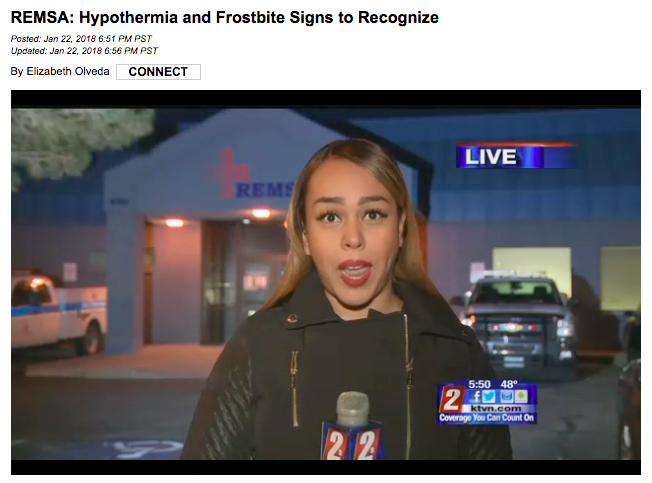Hypothermia and Frostbite Safety Tips

During the cold winter months, hypothermia and frostbite are always possible, and need to be considered serious health threats – especially with senior citizens and small children. To protect yourself and loved ones, it is important to understand hypothermia and frostbite, and how to prevent them.
Hypothermia and its main symptoms
Hypothermia occurs when the body temperature dips below the optimal 98.6 degrees Fahrenheit. Symptoms usually take effect in three stages. The first stage is mild hypothermia. It is characterized by bouts of shivering, grogginess and compromised thinking. The second stage is moderate hypothermia. Symptoms include violent shivering or shivering with sudden stops, inability to think and pay attention, slow, shallow breathing, or a slow, weak pulse. The severe level of hypothermia has set in when shivering stops. The patient may then lose consciousness. There is little or no breathing. Pulse is weak, irregular or non-existent.
How your body regulates core temperature
- When your outer body layer becomes cold, blood flow increases in an attempt to regulate your body heat.
- When you inner body starts to become cooler than normal, shivering may begin.
- Shivering generates heat through an increase in chemical reactions required for muscle activity. Visible shivering can maximally increase surface heat production by 500 percent. However, this is limited to a few hours because of depletion of muscle glucose and the onset of fatigue. Active exercise is much more efficient at heating than shivering.
- Increasing or decreasing activity will cause corresponding increases or decreases in heat production.
- Behavioral responses, such as putting on or taking off layers of clothing will also result in thermoregulation.
Who is at risk for hypothermia?
The elderly and small children are most at risk for hypothermia. However, people who already have something wrong with them are also at a higher risk, as they may not be aware of how severely they are exposing themselves to the cold.
The main risk groups are:
- People who have been involved in accidents;
- Patients with mental illness;
- People with heart problems;
- Hypothyroid patients;
- Patients on sedatives;
- Those who may have consumed alcohol.
Prevention and assessment
Be aware of the causes of hypothermia, which are usually cool to cold temperatures combined with wetness and wind. Constantly evaluate the environmental conditions and the conditions of your group. Here are some guidelines to staying warm and avoiding hypothermia:
- Wear proper clothing. Choose materials that keep you warm even when wet.
- Wetness equals trouble. Have proper rain gear to keep you and your clothing dry.
- Eat small amounts of food at frequent intervals to maintain the body’s energy reserves. Carry carbohydrates to snack on, because they provide quick energy, and protein and fat to eat before bed, because they burn slowly, providing energy overnight. Try not to push yourself to your physical limits in cold weather. Always leave your body with energy in reserve.
- Stay well hydrated. Dehydration quickens hypothermia, so force yourself to drink, even if you do not feel thirsty – up to 4 quarts a day in the winter or hot summer. Drink hot liquids. Try to avoid drinking excessive cold fluids since body heat is used to warm them to body temperature.
- Avoid caffeine. It is a vasoconstrictor that increases the chances of peripheral frostbite.
- Avoid alcohol. It is a vasodilator and increases heat loss.
- Adjust your clothing frequently so that you are neither too hot nor too cold. If you are too hot and you begin to sweat, the wet clothing will rob you of heat 25 times faster than dry clothing. Be aware of the impact of wind chill on increasing the rate of heat loss.
- Have pairs of people zip their sleeping bags together and sleep together as a preventative measure on cold nights.
- Be alert to sudden weather changes and be able to make a quick evaluation of your group’s condition. Has the temperature dropped? Do people have their hats on? Has everyone been eating? Drinking? Is everyone wearing wind or rain gear? What is the condition of the weakest member of the group?
How to determine if someone is hypothermic
- Ask the person a question that requires higher reasoning in the brain (to count backward from 100 by nines). If the person is hypothermic, she won’t be able to do it. (Note: there are other conditions, such as altitude sickness, that can also cause changes in reasoning ability.)
- If shivering can be stopped voluntarily, it is mild hypothermia. If shivering cannot be stopped voluntarily, it is moderate to severe hypothermia.
- If you can’t get a radial pulse at the wrist, it indicates a core temperature below about 90° F (32° C). Check pulse and respirations carefully. Even after a full minute, you may not be able to detect a pulse or respirations and yet the person may still be alive. The body may be using a massive shell/core response to maintain basic life functions.
- A severely hypothermic person may appear dead. The person may be rigid, blue and curled up in a fetal position. Try to open his/her arm up from the fetal position; if it curls back up, the person is alive. Dead muscles won’t contract – only live muscles.
Wind chill effects
Wind chill can have a major impact on heat loss through convection. As air heated by your body is replaced with cooler air pushed by the wind, the amount of heat you can lose in a given period of time increases. This increase is comparable to the amount of heat you would lose at a colder temperature with no wind.
What is the treatment for hypothermia?
The first step is to contact emergency services since extreme hypothermia requires urgent professional attention. All cold, wet clothing should be replaced with warm, dry clothing to prevent further heat loss immediately.
If breathing has stopped and there is no pulse, cardiopulmonary resuscitation (CPR) should be attempted until the emergency services arrive.
Rapid re-warming with hot water or massaging cold extremities should be avoided as, if done improperly, it could lead to serious tissue damage.
Do not give alcohol or nicotine products to someone suffering from hypothermia.
How can hypothermia be prevented?
The key rules are to wear many layers of clothing, drink plenty of fluids and hot drinks (but not alcohol) and keep well nourished. Maintaining movement to keep circulation up is also advised.
Frostbite and its symptoms
Frostbite is an injury caused by freezing of the skin or other body tissues. Although most frostbite occurs in cold weather, it can have other causes as well, including mishandling of refrigerants (dry ice, Freon), improper use of ice packs or inhalant abuse. Mechanical injury and dehydration of cells occur as ice crystals form in the tissue, and further damage to the area results from insufficient blood flow, also known as ischemia.
Frostbite requires treatment in a specialized center, frequently in a burn unit because of the similarity of some of the treatments.
Areas that have become numb should be covered in loosely fitting, warm and dry clothing and removed from the cold environment. Frostbitten limbs should be elevated, padded and splinted, and the victim should be transported to a hospital.
Care for frostbite
Rapid re-warming with water at a measured 104-108 degrees should only be done if (1) the affected part will not be subjected to cold again and (2) there is no close medical facility available. Avoid rubbing the area, as that may increase skin injury. Refrain from using heat from a campfire or tailpipe. Leave blisters intact. Avoid alcohol consumption or smoking.
Illness, alcohol or drug misuse and motor vehicle breakdowns frequently lead to civilian frostbite injury. The risk for frostbite is increased by a previous cold injury, diabetes (which may impair both circulation and sensation), use of beta-blocker drugs, hardening of the arteries or smoking.
When frostbite is suspected, medical care should be sought immediately. Frozen tissues are susceptible to physical injury and should not be rubbed or massaged. In addition, restrictive clothing or jewelry should be removed, and if the feet are involved, the patient should be carried and not allowed to walk.
Frostbitten skin is hard, pale, cold and has no feeling. When skin has thawed out, it becomes red and painful (early frostbite). With more severe frostbite, the skin may appear white and numb (tissue has started to freeze). Very severe frostbite may cause blisters; gangrene (blackened tissue that died after blood vessels froze); or hard, frozen skin (frostbite can penetrate all the way down to blood vessels and bone).
Factors that contribute to frostbite
Extreme cold; wet clothes; high winds; and poor circulation, which can be caused by tight clothing or boots, cramped positions, fatigue, certain medication, smoking, alcohol use or diseases that affect the blood vessels, such as diabetes.
How to avoid being frostbitten
Wear suitable clothing in cold temperatures and protect susceptible areas. In cold weather, wear mittens (not gloves); wind-proof, water-resistant, many-layered clothing; two pairs of socks (cotton next to skin, then wool); and a scarf and a hat that cover the ears (to avoid substantial heat loss through the scalp).
Before anticipated prolonged exposure to cold, don’t smoke or drink alcohol, and get adequate food and rest. If caught in a severe snowstorm, find shelter early or increase physical activity to maintain body warmth.
